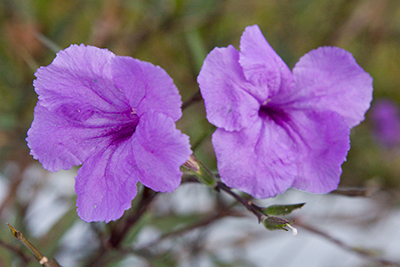In the vibrant tapestry of Florida’s flora, two plants stand out – the invasive Mexican Petunia and the native Tropical Sage (Salvia coccinea). While one has found its way into gardens and landscapes, the other has deep roots in Florida’s native ecosystem. In this blog post, we will delve into the intriguing world of these plants, understanding their origins, characteristics, and the impact they have on Florida’s biodiversity.
The Invasive Mexican Petunia (Ruellia simplex)
The Mexican Petunia, with its delicate blue to purple flowers and lush green leaves, might seem like a charming addition to your garden. Originating from Mexico, this plant has, however, found itself on the invasive species list in many regions. In Florida, this plant has been classified as a highly invasive plant meaning it can spread easily from home gardens and spread into natural areas where it crowds out native species. Its rapid growth and ability to spread easily have made it a concern for native plant enthusiasts and environmentalists alike.
PLease note, due to the rules of taxonomy, the Latin name for Mexican petunia has changed many times. When you are out purchasing plants, be sure it’s either the native caroliniensis or a sterile cultivar. When in doubt, ask the seller or check out the UF/IFAS Extension Gardening Solutions website.

UF/IFAS Extension Gardening Solutions
The Florida Native Tropical Sage (Salvia coccinea)
Contrastingly, the Tropical Sage, or Scarlet Sage, is a native Florida plant belonging to the Salvia genus. With its brilliant red tubular flowers (sometimes white or pink in color) and lush green foliage, it’s a favorite among gardeners and native plant advocates. Unlike the Mexican Petunia, the Tropical Sage has evolved alongside Florida’s native fauna, making it an essential part of the local ecosystem.
The Scarlet Sage serves as a vital nectar source for hummingbirds, butterflies, and bees. Its adaptability to various soil types and climates makes it an excellent choice for Florida gardens. Moreover, it requires less water and maintenance, making it an eco-friendly alternative to invasive species.

Photo by Carl E Lewis
Balancing Act: Cultivation and Conservation
In the battle between invasive and native species, gardeners and nature enthusiasts play a crucial role. By choosing native plants like the Tropical Sage, individuals contribute to the preservation of Florida’s unique biodiversity. Local nurseries often offer native plant varieties, promoting sustainable gardening practices.
Additionally, staying informed about invasive species like the Mexican Petunia is essential. Proper disposal of garden waste and avoiding the introduction of invasive plants to new areas can prevent their spread. Communities and local authorities can also organize awareness campaigns to educate residents about the impact of invasive species.
In the intricate web of nature, every plant has a role to play. While the Mexican Petunia enchants with its beauty, it reminds us of the delicate balance that sustains our ecosystems. On the other hand, the Scarlet Sage stands as a symbol of resilience, deeply rooted in Florida’s soil.
By embracing native species and understanding the consequences of introducing invasive ones, we can protect the natural heritage of Florida. Through education, awareness, and conscious gardening practices, we can ensure that future generations inherit a diverse and thriving environment. Let us celebrate the beauty of native flora and work together to preserve Florida’s natural wonders for years to come.
Note: All images and contents are the property of UF/IFAS.



